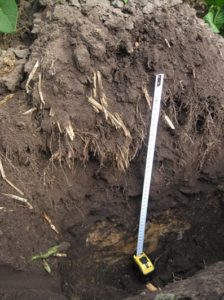Soil
Home > Soil > What does soil deliver? > Organic matter and humus
Organic matter and humus
Fresh organic matter enters the soil in the form of crop residues, organic manure or compost, where it is partially broken down by soil life. Young organic matter is partly decomposed organic matter that has been added to the soil in the form of crop residues, roots and animal and organic manure. The readily degradable fraction decomposes quickly. This process releases nutrients such as nitrogen, phosphate and sulphur for uptake by the crop.
The fraction of organic matter remaining in the soil one year after application is known as effective organic matter (EOM). The amount of effective organic matter varies widely: compost has a high proportion of effective organic matter because it has already been partly converted during the composting process. Fresh crop residues contain relatively little effective organic matter. Nevertheless, there are major differences between crops. The fraction of effective organic matter in cattle manure is larger than in pig manure.

The decomposition of organic matter leaves behind a number of substances that soil life finds difficult to convert, such as lignin and phenols. In addition, soil life forms new products that are not readily degradable. This process of converting fresh organic matter into stable organic matter is known as humification. The humification coefficient is the ratio of effective organic matter to fresh organic matter. These stable compounds together form the humus, which plays an important part in binding positively charged nutrients, such as calcium, magnesium, potassium and sodium, due to its negative charge.
Soil organic matter decomposes slowly. Organic matter must be supplied annually to maintain levels. On average, about 2-3% of organic matter content degrades annually, but this percentage varies. In general, the relative degradation rate is low (around 1%) in soils with a high organic matter content (e.g. Peat Colonies soils) and high (up to 10%) in soils with low organic matter content (e.g. dune sand soils). The average organic matter requirement is between 1,500 and 3,000 kg of effective organic matter per ha per year.
Source:
Kennisakker, adviesbasis voor de bemesting van akkerbouwgewassen
www.kennisakker.nl


